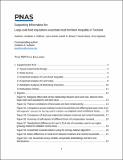Large-scale land acquisitions exacerbate local farmland inequalities in Tanzania

View/
Date
2023-07-31Author
Sullivan, Jonathan
Sami, Cyrus
Brow, Daniel
Moyo, Francis
Agrawal, Arun
Metadata
Show full item recordAbstract
Land inequality stalls economic development, entrenches poverty, and is associated with environmental degradation. Yet, rigorous assessments of land-use interventions attend to inequality only rarely. A land inequality lens is especially important to understand how recent large-scale land acquisitions (LSLAs) affect smallholder and indigenous communities across as much as 100 million hectares around the world. This paper studies inequalities in land assets, specifically landholdings and farm size, to derive insights into the distributional outcomes of LSLAs. Using a household survey covering four pairs of land acquisition and control sites in Tanzania, we use a quasi-experimental design to characterize changes in land inequality and subsequent impacts on well-being. We find convincing evidence that LSLAs in Tanzania lead to both reduced landholdings and greater farmland inequality among smallholders. Households in proximity to LSLAs are associated with 21.1% (P = 0.02) smaller landholdings while evidence, although insignificant, is suggestive that farm sizes are also declining. Aggregate estimates, however, hide that households in the bottom quartiles of farm size suffer the brunt of landlessness and land loss induced by LSLAs that combine to generate greater farmland inequality. Additional analyses find that land inequality is not offset by improvements in other livelihood dimensions, rather farm size decreases among households near LSLAs are associated with no income improvements, lower wealth, increased poverty, and higher food insecurity. The results demonstrate that without explicit consideration of distributional outcomes, land-use policies can systematically reinforce existing inequalities.
